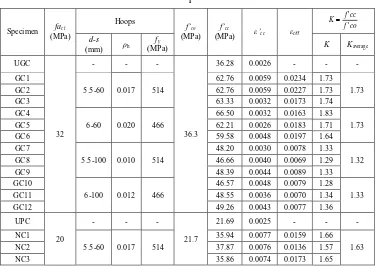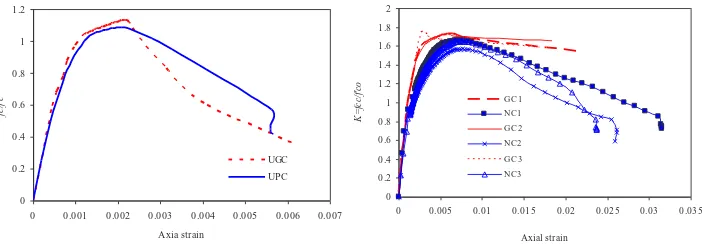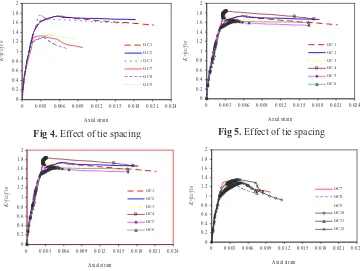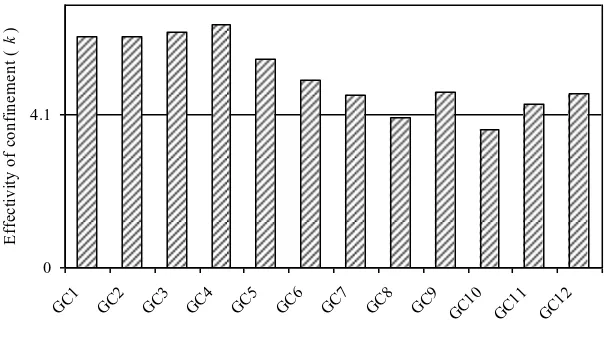Behavior of Geopolymer Concrete Confined by
Circular Hoops
Muslikh1,*, N. K. Anggraini2, D. Hardjito3, and Antonius4
1Dept. of Civil and Environmental Engineering, Gadjah Mada University, Yogyakarta, Indonesia 2Master Student of Civil Engineering, Diponegoro University, Semarang, Indonesia
3Professor of Civil Engineering, Petra Christian University, Surabaya, Indonesia 4Professor of Civil Engineering, Sultan Agung Islamic University, Semarang, Indonesia
Abstract. This paper discusses the behavior of geopolymer concrete subjected to passive confinement under compression loads. The confinement is induced by the use of lateral hoops, assembled from un-deformed reinforcing bars. To compare the effect of confinement, identical specimens were produced using conventional concrete with the similar concrete compressive strength. The cylinder specimens were 100 mm in diameter and 200 mm in height, and the hoops were placed on the outer most fibers of the cylinders, perpendicular to the line of loading, with no concrete cover. The parameters analyzed in this study were the steel bar to concrete volumetric ratio, the hoop spacings and the steel yield stresses. The experimental results show that unconfined geopolymer concrete were very brittle compared to the unconfined Portland cement concrete. The strength enhancement (K value) of the confined geopolymer concrete was higher than K value of Portland cement concrete. Confined geopolymer concrete also has better deformability compared to the confined Portland cement concrete. The average confinement effectiveness of geopolymer concrete also has a higher value than that commonly used in the Indonesian Concrete Standard (SNI), that is 4.1. The results were further assessed to the most recent experimental test results conducted in this area.
Keywords: geopolymer, confinement, hoops, stress-strain
1 Introduction
Inelastic deformability of reinforced concrete columns is essential for overall strength and stability of structures during a strong earthquake. The inelastic deformation of the structural column can be significantly achieved by confining the concrete core [1], or by increasing the matrix bonding of concrete materials such as fiber concrete [2,3]. On the other hand, the current development of concrete technology also leads and prioritized to the eco-friendly concrete. Geopolymer concrete is known as an environmentally friendly and energy efficient material. Ekaputri [4] reveals that geopolymer concrete is the best technology in overcoming the problem of national coal ash waste crisis in Indonesia. Compared to other types of concrete, geopolymer concrete produces the least amount of CO2 emissions, advanced materials with many advantages (fireproof, rustproof and high strength). The process of making geopolymer concrete does not require much energy, as does the cement making process which requires at least temperatures up to 800oC. By heating ± 60oC for one full day can be produced high strength geopolymer concrete. Therefore, geopolymer concrete can reduce greenhouse gas emissions.
________________________
Currently, research on geopolymer concrete is also evolving. Mechanical geopolymer concrete has excellent ability to withstand sulfate attacks, has relatively low creep and shrink properties, making it suitable for structural applications [5-8].
The stress-strain model of geopolymer concrete has also begun to be proposed, among them by Nguyen et al. [9] and Diaz-Loya [10]. However, Diaz-Loya revealed that geopolymer concrete is more brittle when compared with normal concrete.
Compared with steel fibrous concrete, the use of geopolymer concrete within the structure is still very limited. As a result, geopolymer concrete design equations are still not widely developed. Several geopolymer concrete research on structures are still performed and developed, such as column structure, and precast structures [11-13]. The triaxial behavior of geopolymer concrete was also evaluated by Giasuddin et al. [14], where based on the test results, indications that the geopolymer concrete brittle behavior changes to ductile when active confined are applied. Another way to increase the ductility of geopolymer concrete is by installing CFRP confinements [15]. The results of the investigation Ganesan et al. [16] concluded that an increase in concrete strength of confined geopolymer concrete is known to be not significantly different from that of confined normal concrete.
In this study, an evaluation of the behavior of strength and ductility of geopolymer concrete confined by a round section hoops has been carried out. Experimental tests were conducted with the primary objective of evaluating the collapsed behavior of confined geopolymer concrete by reviewing the design parameters of reinforcement bars such as the volumetric ratio (ρh) and spacing (s).
2 Experimental Program
2.1 Materials
Concrete materials are designed into two types, i.e. geopolymer concrete as the main material (code: GC) and normal concrete (code: NC) as comparison. The confined concrete specimen is controlled by the unconfined concrete, whereas for the geopolymer concrete, the UGC code is given. The normal concrete is coded as UPC. The coarse aggregates have a maximum diameter size of 19 mm and are designated as local sand from the area in Central Java. The composition of the concrete mixture is shown in Table 1. The plain confining steel reinforcement has a diameter (d) of 5.5 and 6 mm, with a yield stresses (fy) of 514 and 466
MPa respectively.
Table 1. Composition of Concrete Mix Design
Material
Geopolymer Concrete
(kg/m3)
Normal Concrete (kg/m3)
Coarse Aggregates 1209.6 1209.6
Fine Aggregates 806.4 806.4
Fly Ash 561.6 -
Cement 445.6
Natrium Hydroxide Fluid (8 Molar) 100.8 -
Natrium Silicate Fluid 201.6 -
2.2 Specimens and instrumentations
ρ
direction are used to measure the deformation of the specimen in the direction of the load. The FLA-6-11 type strain gages are installed on the confinement reinforcement. The cables from both LVDT and strain gages are then connected to the data logger.
2.3 Data Execution and Data Analysis of the Experimental Results
The concentrically loading is conducted on the specimens, with a constant increment, and monotonic mode. The compression testing machine has an effective capacity of 1800 kN and was deformation controlled. The analysis of stress and strain on confined concrete were based on the calculations proposed by Antonius [17]. The increased strength of confined concrete (K) is defined as the ratio between confined concrete stresses at the maximum response (f'cc) to the unconfined concrete stress (f'co).
3 Results and Discussion
The value of stresses, strains and increased strengths of confined concrete (K = f'cc / f'co) of
all specimens are presented in Table 2.
3.1 Failure modes and geopolymer effects
Fig 1 shows the failure modes of both confined normal concrete and confined geopolymer concrete. In general, the collapse behavior of the two types of concrete does not show a significant difference. The confinement caused a non-brittle failure mode, the direction of cracks running vertical (columnar) and the crack propagation is observed to be distributed evenly around the surface of the specimen.
Table 2. Values of experimental result
Fig 1. Failure modes
Following the visual observations to the failure behavior, a comparison of stress-strain behavior between the unconfined geopolymer concrete and unconfined normal concrete is conducted. The method chosen in this study is by normalizing the compressive strength of each type of concrete to the standard cylindrical concrete compressive strength (f'c). Fig 2 shows the data assessment. It can be seen that the curves prior to reaching the peak, coincides. The initial stages even show an exact behavior between the confined and unconfined specimens. For the post-peak behavior, it is seen that the unconfined geopolymer concrete is more brittle, it can be concluded that the existence of reinforcement becomes very important in geopolymer concrete.
The data in Table 2 underlines the above-mentioned statements, since the unconfined concrete peak strain comparison between the geopolymer concrete and normal concrete are almost identical, with values of 0.0026 and 0.0025 respectively.
The stress-strain behavior evaluation between the confined geopolymer and normal concrete is shown in Fig 3. From this figure, it is demonstrated that the confined concrete peak stress (f'cc) of each specimen was normalized to the unconfined concrete peak stress (f'co). The normalization also automatically reveals the increase in strength of confined concrete (K). Comparisons were made between specimens GC1 versus NC1, GC2 versus NC2 and GC3 vs NC3. Based on the data in Table 2, the values of K and deformability of the confined geopolymer concrete are higher than the values obtained from the confined normal concrete.
Fig 2. Comparison of unconfined concrete Fig 3. Comparison of confined concrete
0 0.2 0.4 0.6 0.8 1 1.2
0 0.001 0.002 0.003 0.004 0.005 0.006 0.007 Axia strain
fc
/f'
c
UGC UPC
0 0.2 0.4 0.6 0.8 1 1.2 1.4 1.6 1.8 2
0 0.005 0.01 0.015 0.02 0.025 0.03 0.035
Axial strain
K
=
fc
c/f'
co
GC1 NC1 GC2 NC2 GC3 NC3
3.2 Effect of parameter change on the confined concrete design
Basically, changing the confinement reinforcement spacing will have implications on the shifting of the confinement reinforcement volumetric ratio values. As with confined normal concrete, closer spacing of confinement reinforcement, higher volumetric ratios and confinement reinforcement yield stress, will yield in the increase of the K value (Table 2), while the behavior of the post-peak for confined concrete will exhibit a more pronounced slope gradient change and a more ductile specimen behavior.
Fig 4, 5, 6 and 7 illustrate the effect of confinement reinforcement parameters. The confined geopolymer concrete behavior demonstrates the utility of highly effective confinement and possesses analogous behavior properties to the confined normal concrete. This behavior is very advantageous if the confinement utilization of geopolymer concrete is applied to earthquake resistant concrete column structures.
Fig 4. Effect of tie spacing Fig 5. Effect of tie spacing
Fig 6. Effect of volumetric ratio Fig 7. Effect of volumetric ratio
3.3 Effectiveness of confinement
The effectiveness of the confinement adopted by the current Indonesian National Standard (SNI 2847-2013) for structural concrete requirements [18], has a magnitude of 4.1. The value is basically based on the data of normal concrete test results [1]. Furthermore, the experimental results data in this study (Table 2) were processed to obtain the confinement effectivity value (k) of each specimen, using equation (1) below [1]:
2
0 0.003 0.006 0.009 0.012 0.015 0.018 0.021 0.024
Axial strain
0 0.003 0.006 0.009 0.012 0.015 0.018 0.021 0.024
Axial strain
0 0.003 0.006 0.009 0.012 0.015 0.018 0.021 0.024
Axial strain
0 0.003 0.006 0.009 0.012 0.015 0.018 0.021 0.024
In the above equation, the peak confined concrete stress (f'cc) and unconfined concrete
stress (f'co) are taken from Table 2, and the lateral stress f2is calculated based on the equation
below [16]:
c y s 2
s.d .f 2.A
f (2)
Fig 8 shows the calculated results of the confinement effectiveness for each specimen. The data are also compared to the confinement effectiveness value adopted in SNI (k = 4.1). Based on the figures, except for the GC8 and GC10 specimens, the k values of all specimens are higher than the confinement effectiveness based on SNI. These results show that the circular cross-sectional hoop is very effective in increasing the strength of confined concrete. Furthermore, the confinement effectiveness in confined geopolymer concrete is higher than the confinement effectiveness for normal concrete.
Fig 8. Effectivity of confinement
4 Conclusions
Geopolymer concrete has excellent mechanical properties and is environmentally advantageous because the material does not consume cement. The CO2 that is produced as residue during the cement-making process can be minimized maximally. These conditions make geopolymer concrete as one of the environmentally friendly construction materials. However, geopolymer concrete is brittle compared to normal concrete using cement, so the installation of confinement reinforcement on geopolymer concrete becomes very important in order to increase ductility, especially for earthquake resistant structures. The value of the geopolymer concrete peak strain remains within the range of the values customary assumed in normal concrete. The effect of confinement reinforcement reduction, higher volumetric ratios and higher reinforcement yield stresses on confined geopolymer concrete, will result an increase in strength of the confined geopolymer concrete, and improves the material ductility. It is also concluded that this behavior is similar to the effect of changing the reinforcement parameters in the confined normal concrete. Further, it can be concluded that the confinement effectiveness for geopolymer concrete has a higher degree of effectiveness as compared to the confinement of normal concrete. This research has opened up new insights
0 4.1
GC1 GC2 GC3 GC4 GC5 GC6 GC7 GC8 GC9 GC10 GC1
1 GC1
2
Specimens
E
ff
ec
tiv
ity
o
f c
o
n
fin
em
en
t (
k
and shows a good prospect in the direction of structural element’s research developments for
geopolymer concrete, in the future.
Acknowledgment. The implementation of this research is a collaboration of researchers from Gadjah Mada University, Diponegoro University, Petra Christian University, Sepuluh Nopember Institute of Technology, Sultan Agung Islamic University. The support received for this research is gratefully acknowledged.
References
1. Antonius, Asian Journal of Civil Engineering, 15, 245 (2014).
2. P. Paultre, R. Eid, Y. Langlois, Y. Lévesque, Journal Of Structural Engineering, 136, 1225 (2010).
3. Antonius, A. Widhianto, D. Darmayadi, Gata D. Asfari, Asian Journal of Civil Engineering, 15, 655 (2014).
4. J.J. Ekaputri, S. Junaedi, Wijaya, Procedia Engineering, 171, 572 (2017).
5. A. Noushini, F. Aslani, A. Castel, R.I. Gilbert, B. Uy, S. Foster, Cement and Concrete Composites, 73, 136 (2016).
6. D. Hardjito, S.E. Wallah, D.M.J. Sumajouw, B.V. Rangan, ACI Materials Journal, 101, 467 (2004).
7. D. Hardjito, S.E. Wallah, D.M.J. Sumajouw, B.V. Rangan, Australian Journal of Structural Engineering, 6, 1 (2005).
8. L.K. Turner, F.G. Collins, Construction and Building Materials, 43, 125 (2013). 9. K.T. Nguyen, N. Ahn, T.A. Le, K. Lee, Construction and Building Materials, 106, 65
(2016).
10. E.I. Diaz-Loya, E.N. Allouche, S. Vaidya, ACI Materials Journal, 108, 300 (2011). 11. D.M.J. Sumajouw, D. Hardjito, S.E. Wallah, B.V. Rangan, Journal of Material Science,
42, 3124 (2007).
12. P.K. Sarker, Materials and Structures, 42, 715 (2009).
13. N.A. Lloyd, B.V. Rangan, 2nd International Conf. on Sustainable Construction Materials
and Technologies, Ancona, Italy (2010).
14. H.M. Giasuddin, J.G. Sanjayan, P.G. Ranjith, International Journal of Civil, Environmental, Structural and Architectural Engineering, 7, 521 (2013).
15. W. Lokuge, W. Karunasena, Journal of Composite Materials,
DOI:10.1177/0021998315597553, 1 (2015).
16. N. Ganesan, R. Abraham, S. Deepa Raj, D. Sasi, Construction and Building Materials, 73, 326 (2014).
17. Antonius, International Journal of Technology, 6, 217 (2015).




